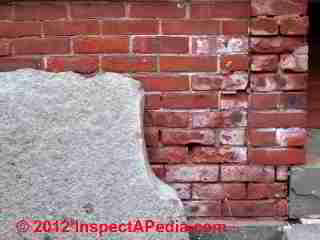 Brick Wall Leak Diagnosis & Repair
Brick Wall Leak Diagnosis & Repair
Brick wall crack detection, evaluation, repair
- POST a QUESTION or COMMENT about structural brick foundations & brick walls: crack, leak, or movement diagnosis, defects, & repairs, risks of collapse
Brick wall leaks:
This article describes the diagnosis & repair of leaks in structural or solid brick building walls.
While extensive reconstruction, even outer brick veneer replacement may be required on some leaky brick buildings, options including tuckpointing, use of sealants, and correcting flashing defects may suffice in many leaky brick wall cases.
We include warnings about hidden damage from leaks in brick structures and risks of falling bricks, structural collapse, or water damage.
This article series explains how to recognize, diagnose, & repair brick foundation & brick wall defects & failures such as cracks, spalling, movement, bulging, leaks, damage due to impact, settlement, frost or water damage, and other problems.
InspectAPedia tolerates no conflicts of interest. We have no relationship with advertisers, products, or services discussed at this website.
- Daniel Friedman, Publisher/Editor/Author - See WHO ARE WE?
Structural Brick Wall Leaks, Damage & Repair Options
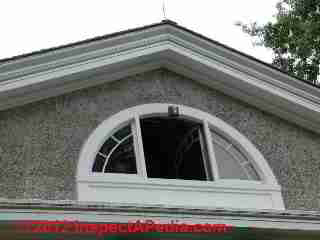 Reader Question: Solid Brick Wall Leaks, Troubleshooting, Repair Options for Sealing a Curved or Round Top Window in a Brick Veneer Wall, Stucco Surface, or Structural Brick Wall
Reader Question: Solid Brick Wall Leaks, Troubleshooting, Repair Options for Sealing a Curved or Round Top Window in a Brick Veneer Wall, Stucco Surface, or Structural Brick Wall
I had a question I hoped you could help me answer.
We have a leak in an interior wall. We have torn out part of the inside of the wall and have discovered that the leak is coming through the brick mortar above the window.
[Click to enlarge any image]
If we completely seal and waterproof the brick wall, and install synthetic rock over the brick, could this cause any type of mold or mildew problem behind wall or the sheetrock wall on the inside of the house?
I have been told by some brick people a potential interior mold problem could be caused if we used a non breathable sealer on the brick wall. We just need to stop the leak and we never want it to come back again.
We have been working on this for several months and would greatly appreciate your help.
We feel you may have the expertise to help us correctly know what to do to correctly fix our leak and not cause any mold problem down the road.
We would greatly appreciate your help, - Anon.
[Our photo of a curved-top window in a stuccoed wall (above left) is from a different structure than the one described by the reader, though the sealing problems remain the same - Ed. ]
Reply:
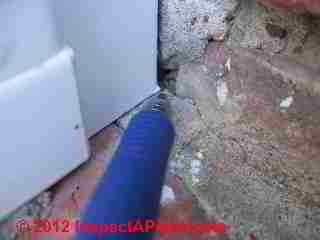 In general it is a better and more reliable strategy to fix building leaks from outside the structure rather than relying on layers of interior waterproofing. I presume you're talking about installing drywall over the brick interior surface of the wall - or perhaps you meant something like Permastone? I'm unclear on that step.
In general it is a better and more reliable strategy to fix building leaks from outside the structure rather than relying on layers of interior waterproofing. I presume you're talking about installing drywall over the brick interior surface of the wall - or perhaps you meant something like Permastone? I'm unclear on that step.
But I'd want to know that the wall is not leaking before laminating more stuff on its inside surfaces.
Even a small opening (photo at left) at a window set in a brick wall can result in a lot of water leakage into the building wall or interior, especially when the exterior wall sees a combination of wind-blown rain and heavy rainfall - a lot of water running down the vertical face of the brick wall finds and enters any opening that it can.
A window or door set into masonry and designed not to leak, uses a combination of careful attention to flashings, especially head flashings over windows and doors, sealants at vertical sides of windows and doors, and properly sloped as well as sealed window sills and thresholds.
Reader Follow-up: - Do we Need Weep Holes in a Solid Brick Structural Wall?
I had another couple of questions.
1. The brick around our house is solid and does not have any weep holes.
I know now they also did not flash around any of the windows or bottom of walls. We have a raked finish. Our home is 9 years old. As I mentioned we have a leak through the mortar above one of our windows. Although we have no flashing, do we need to have weep holes put in the brick?
Should they be located above the interior floor level or as low as possible above ground level?
2. We have foundation vents, but we keep them closed because we have used a cleanspace encapsulation system in the crawlspace (we also have a dehumidfier).
3. Could the foundation vents be opened and turned into correct weep areas?
I appreciate your help. Thank you, - Anon.
Reply:
1. Not if it's a solid masonry wall, but you may need to review mortar joints and tuckpoint any in bad shape, loose, fallen out; do not caulk or seal steel lintels over windows or doors against the brick; If the wall were a brick veneer wall or a brick wall that included a hollow rain space between wythes of brick then weep holes may be in order.
See BRICK VENEER WALL CONSTRUCTION
Details about weep holes in brick walls are
Also see BRICK WALL DRAINAGE, Flashing & Ventilation Products.
2. I agree, better current wisdom is convert the crawl to conditioned space;
3. I must not understand your question as foundation vents don't weep nor drain a brick wall. Besides, solid brick? No.
Reader Follow-up:
Thank you very much for your reply. We also have a leak in a window we have not been able to stop. I have sent you a picture (at left) to help you see it. We have had the inside of the wall cut out to the brick. We have water that is coming in (possibly through mortar or brick or both).
When we put a hose to it, it is like a small waterfall on the inside of the house, behind the brick wall, above the window (where the ladder is). We have a raked joint finish in the brick.
I have put an acrylic caulk (lexor) with my fingernail into the very small cracks in the head joints of the brick. I had thought about using a breathable brick water repellant called siloxane (prosco is the company). I am hesitant because I do not think this will permanently stop the leak.
My wife and I want to permanently stop the leak before we install a new window and fix the inside of our home.
My questions are:
1. If we completely waterproofed the brick wall and used synthetic (faux) stone over the wall, is there any way this method could cause a mold problem on the inside of the wall where the sheetrock is located?
2. We have several weak mortar areas around the home. If we have a mason dig them out and repoint them, could this cause any type of worse water damage? I would like to use brick mortar if it is possible to permanently fix the problem.
One of our contractors stated digging out the mortar would cause void, and since we have a raked finish, it probably would not work.
What is the best way to fix the bad mortar areas with a raked finish?
3. If we did use siloxane based sealer and we tested it and it worked, do you think it would be work to stop the leak if we just reapply it every couple of years?
We have had several different contractors and window persons in our area try to help us, but we continue to get many different answers. I have also sought help from many others, but we can not decide how to correctly fix the problem.
We have been dealing with this problem for several months. After reading several articles on your site yesterday, I felt that you would have the expertise to help us decide the correct way to fix our water leak. My wife and I would very much appreciate your help with our frustrating problem. Thank you for your help, - Anonymous by request
Reply:
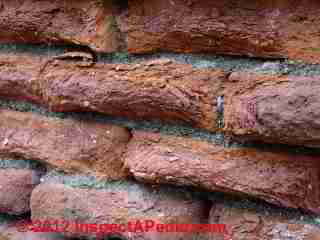 Your photo reminded me of a prof I had who wrote on the board in 1/8" high letters - when we asked him to write bigger he wrote in 3/16" high letters.
Your photo reminded me of a prof I had who wrote on the board in 1/8" high letters - when we asked him to write bigger he wrote in 3/16" high letters.
But I did see an archtop window in brick - difficult to seal or flash; When you install a new window look into a custom curved flashing with a counterflashing that is cut into the brick and that cut sealed;
Spray silicone ased waterproofing masonry sealant coatings (including Sure Klean® Weather Seal Siloxane PD) improve the water resistance of solid masonry surfaces like brick but they don't seal openings, gaps, leaks, and have about a one-year life in my experience.
If your brick wall exterior looked like the example we show at left, unfortunately the proper repair is removal and replacement of those adly worn, crumbling bricks, using a matched mortar in the replacement.
If the bricks in your wall are basically intact and retain their original hard fired surface, tuckpointing open mortar joints and flashing at windows and doors should be in your repair and maintenance plans.
A silicone or other brick sealant spray or paint-on coating won't help the waterfall-at-the-window leak you described. You can make a temporary seal from outside using geocel or a similar high grade sealant/caulk, pending window replacement.
At left we show a bad brick wall repair, using a too-hard (too high in portland cement) brick mortar joint repair that also is not matched in the slightest to the original wall's mortar joint color, texture, nor tooling.
This building, on the Vassar College Campus in Poughkeepsie, New York, had enough deterioration that ultimately the college maintenance department rebuilt this collapsing wall section and fixed the roof spillage problem that was causing the damage.
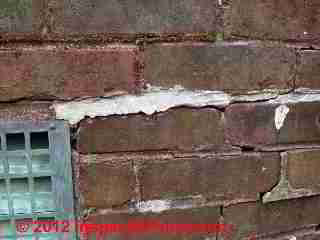 The right repair for deteriorated mortar is to excavate the loose stuff to sufficient depth that new mortar can be tucked into the joints; be SURE to use mortar that is
The right repair for deteriorated mortar is to excavate the loose stuff to sufficient depth that new mortar can be tucked into the joints; be SURE to use mortar that is
- color and texture matched to the old mortar - or your house will look horrible
- as soft as the original mortar or in a freezing climate you risk future brick spalling damage
For repair of deteriorated brick wall mortar joints
see TUCKPOINTING BRICK & RE-POINTING
and
see
- Mack, Robert C., FAIA & Anne E. Grimmer, ASSESSING CLEANING AND WATER-REPELLENT TREATMENTS FOR HISTORIC MASONRY BUILDINGS [PDF] (2000) U.S. National Park Service, Technical Preservation Services, retrieved 2022/10/02 original source: https://www.nps.gov/tps/how-to-preserve/briefs/1-cleaning-water-repellent.htm
Steve Bliss comments on brick wall leak and window head flashing concerns
Steven Bliss gave us a few helpful remarks and recommended the JLC articles I list below: Steve writes: "I am no expert on brick veneer or Drivit (aka, EIFS), but know that EIFS have generated numerous lawsuits for leaks, especially around windows. JLC has published several articles over the years on leaky synthetic stucco systems (ones marked FREE you can view at the JLC website without a password).
From my cursory reading of the above case, I can’t quite tell where to stucco ends and the brick begins.
Flashing of flange-type windows is another big problem in any type of wall. I’ve looked into this over the years and written about it in my book Best Practices Guide to Residential Construction, Wiley (November 18, 2005).
However, there’s still a lot of controversy about what is the best approach for integrating the flange, membrane, housewrap, flashing, and siding. Regarding the watertightness of brick veneer, it’s my understanding that it is never really watertight and depends on proper detailing of the weather barrier beneath and weep holes to protect the structure from water damage.
Reader Follow-up:
I have found a person to make a custom curved flashing (finding someone who has ever installed one will take a miracle).
I guess the frustrating thing for us is we had poor work done, I have spent several months researching to find the best and correct way to do the project. I understand what is correct, but the people in our area have either not heard of it, never done it, or have always done it a certain way.
A couple of examples:
Most in our area only use flashing tape to seal top of curved windows.
The others I have found who flash windows, use black rubber because it is flexible and easy to work with - they say they have never had a call back for a leak.
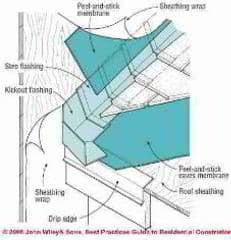 I called the largest brick distributor in the state (Birmingham) and asked about the weep hole products they had. The brick company said the correct protocol was to use weep rope and run it to the weep holes. I talked with a dryvit contractor who just finished a large commercial job (church) in Huntsville. He said they used rope for weep holes.
I called the largest brick distributor in the state (Birmingham) and asked about the weep hole products they had. The brick company said the correct protocol was to use weep rope and run it to the weep holes. I talked with a dryvit contractor who just finished a large commercial job (church) in Huntsville. He said they used rope for weep holes.
I called tamyra (not sure on spelling) to buy weep hole inserts that was pictured in the weep hole article - their machine is broken, can not make the product, and do not know when they will start again.
These are just a couple of examples of what we go through. I greatly appreciate all of your help that you have provided.
Could you please tell me what the counter flashing is. Could you please provide a picture or tell me how to locate one.
Reply: - Counter Flashing & Metal Drip Caps for Windows & Doors
Most flashing designs for roofs (though not for many windows) are made of two pieces. An underpiece intercepts water at the vertical to horizontal (or sloping)( surface and directs it back onto the roof or other draining surface so that it can drain away from or off of the structure rather than into it.
The second or upper piece of flashing, counter-flashing, is designed to intercept water that might run behind the vertical surface of the first flashing.
Counter flashing, then, is a second course of flashing that overlaps the upper end of the vertical portion of roof or other flashings to prevent water that runs down a vertical surface (building wall, chimney side) from passing behind the under flashing.
The upper edge of the counter-flashing is either installed beneath building siding, or is bent over at a 90 degree angle and sealed into a groove cut into the building wall.
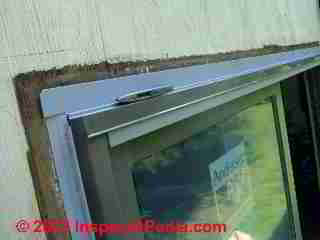 Or some installers use a peel-and-stick membrane beneath the siding and sheathing wrap and over the top of the step flashing, as shown in the illustration at left, courtesy of Steve Bliss & Best Practices Guide to Residential Construction
Or some installers use a peel-and-stick membrane beneath the siding and sheathing wrap and over the top of the step flashing, as shown in the illustration at left, courtesy of Steve Bliss & Best Practices Guide to Residential Construction
Watch out: Some inexperienced installers omit counterflashing and instead rely on simply caulking that vertical upper edge - an unreliable solution.
Metal drip cap over window & doors:
Over windows and doors manufacturers such as Anderson often provide a single piece of flashing designed to do the whole job of keeping water from entering the structure at the top of a window or door.
In a retrofit window or door installation, such as the Anderson sliding glass door shown at left, the factory head flashing or drip cap is installed over the new door frame and inclorporates a vertical flange that will be sealed against the building wall using first flashing tape, and second a horzontal trim board whose top edge is caulked to keep water from running behind the trim.
For details on how to install window & skylight flashing & sealants take a look
at WINDOW FLASHING & SEALING GUIDE
Details about flashing and counterflashing are at are
 at FLASHING ROOF WALL DETAILS
at FLASHING ROOF WALL DETAILS
and
at FLASHING MEMBRANES PEEL & STICK.
In new window or door construction (our photo at left), the uppermost edge of the window or door drip cap or head flashing is installed underneath the finish siding, and the lowermost edge of that head flashing extends out past the horizontal edge of the window or door top trim and is usually bent to include a lip or drip edge to direct water droplets off of the surface so that water doesn't simply run down it or weep back under the flashing by capillary action.
Obviously, you wouldn't try installing flashing tape against a brick wall or brick veneer wall surface.
On a brick wall or brick veneer the head flashing (or counter flashing if it's used) over a window or door are either installed to extend their vertical flange up the wall sheathing beneath the housewrap and beneath the brick veneer (new construction) or the head flashing is bent to a 90 degree and let into a groove cut into the brick wall and then that groove is sealed using a high grade sealant such as Geocel (retrofit or repair construction).
Research & Standards on Masonry Wall Leaks & Leak Repairs
- Allen, M. H., Research Report No. 10, “Compressive and Transverse Strength Tes
- BIA, “Technical Notes on Brick Construction 18A: Accommodating Expansion of Brickwork.” The Brick Industry Association Home. The Brick Industry Association, Nov. 2006.
- BIA “Technical Notes on Brick Construction 18: Volume Changes – Analysis and Effects of Movement.” The Brick Industry Association Home. The Brick Industry Association, Oct. 2006.
- DeVekey, R.C., ''Corrosion of Steel Wall Ties: Recognition, Assessment and Appropriate Action”, Building Research Establishment Information Paper, IP 28/79, Building Research Establishment, Garston, Watford, England, October 1979.
- Fishburn, C.C., ''Water Permeability of Walls Built of Masonry Units”, Report BMS 82, National Bureau of Standards, Department of Commerce, Washington, D.C., April 1942.
- Also seeReferences or Citations at the end of this page
...
Reader Comments, Questions & Answers About The Article Above
Below you will find questions and answers previously posted on this page at its page bottom reader comment box.
Reader Q&A - also see RECOMMENDED ARTICLES & FAQs
On 2021-10-26 by inspectapedia.com.moderator (mod) - suggestions for "waterproofing" a brick wall exposed to flooding
@Anonymous by private email,
Not really, Anon,
Brick "waterproofing" sprays, typically silicone-based, slow the absorption of water into brick but are short lived and definitely do not and can not stop actual water intrusion through the wall from flooding, driven rain, etc.
But understanding how flood waters enter a brick wall and pass through it can be helpful. And there are some things you can do once we've got better understanding of your building's location, wall construction, building site, flood water sources, and the condition of the building's exterior walls.
Flood waters penetrate masonry walls first through openings: cracks, fissures, and penetrations such as at vents, drains, or plumbing and electrical system connections. Flood waters and driven rain also penetrate at inadequately-flashed windows, doors, or similar openings.
The rate of water passage through such actual openings is exponentially greater (100 to 1000 x more) than any moisture penetration through the body brick itself or through the wall's sound mortar joints. And other masonry materials like un-broken stone will leak only at mortar joints.
So you should inspect the building exterior with great care: many actual cracks and openings in masonry walls are not visually obvious and they can be notoriously difficult to spot and then seal properly with mortar, masonry sealants, or other caulk or sealant products.
That difficulty has bred an entire industry of magic bullets, spray on "waterproofing" agents that any honest applicator will tell you will not prevent actual leaks through the wall.
Watch out: in flood zones building foundations often must include flood vents that deliberately allow higher flood waters to actually enter through the foundation wall to the building's basement or crawl space. Why? Because otherwise the pressure of flood waters on the building's foundation can cause a catastrophic building collapse.
Also see the the Recommended Articles listed at the bottom of this page
Also see
BRICK VENEER WALL LEAKS in FLOOD PRONE AREAS
https://inspectapedia.com/structure/Brick_Wall_Weep_Flood_Leaks.php
Please keep us posted on what leak points you find in your building's exterior walls how things progress, and send along photos or additional details if you can.
Such added details can help us understand what's happening and often permit some useful further comment. What we both learn may help us help someone else.
On 2021-10-26 by Anonymous by private email
Is there any product that can be applied on the exterior of brick to at least slow the intrusion of flood waters? No salt water issues. I don’t live near the coast.
On 2021-08-08 by inspectapedia.com.moderator (mod) - fix leaks through wall where siding abuts building
@matthew moran,
Let's start with the most likely causes of leaks into your house for this case
1. gutters are overflowing or downspouts are not getting water well away from house walls
2. the sidewalk doesn't slope away from the building
On 2021-08-08 by matthew moran
my walkway is concert next to my hose now when it rains I mush have a leak
On 2021-05-30 - by (mod) -
@Nilabza[brick wall stain],It would be a mistake to buy a home or any building without having a thorough expert Home Inspection or building inspection by an experienced inspector - one who is working for you without conflict of interest, and therefore is referred to you by an independent source, that is not the seller and not the real estate agent.
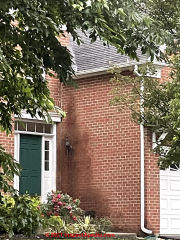
That inspector would be expected to include in the scope of work the condition of the roof and roof drainage system as well as any leaks or water damage to the building.
From your photo, which is of course Very incomplete data, it looks to me as if the roof drainage system isn't working correctly and water is running down the walls in wet weather. That's not something to be scared of but it is something to fix so that we don't have other water damage to the building.
Inspection should include the building's history of water entry and it should report any evidence of current or prior water damage, mold contamination, rot, insect attack, Etc that can happen with a building is wet.
It would be very rare for such an inspection to find conditions so expensive and so terrible that the whole economic structure of the purchase it's called into question.
In other words it's not a buyer sell inspection, rather it's an inspection that allows you to know what repairs the building needs to protect it and to protect your investment and to protect the safety and health of its occupants.
On 2021-05-30 by Nilabza[brick wall stain]
I am about to purchase a home and after two days of rain visited the property to discover a big stain on the brick exterior as shown in the image. [Photo above]
Please advise what could this be and how to remediate . I am very scared so please help urgently
On 2020-08-10 by (mod) - diagnose cause of water leaking out at bottom of wall
I don't blame you for being frustrated, Frust.
You need an accurate diagnosis of the point or points of water entry before planning a repair; otherwise we're just throwing money aimlessly.
I can't diagnose the leak from just your text an photo; an onsite expert will inspect, discuss, perhaps try a water test against the wall starting low and moving upwards,
Watch out: do NOT close out this job before you cut open and inspect wet drywall for mold.
On 2020-08-10 by Frustrated
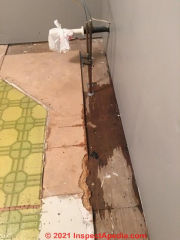 I have a leak in my kitchen from the outside brick
I have a leak in my kitchen from the outside brick
It was discovered during a kitchen remodel
Unfortunately I live in a HOA and have been complaining for over a year for the HOA to fix it so I can install base cabinets, appliances etc. And finally get back to normal!
I’ve had two contractors out 1) states he would excavate
Down about 2-4 (not quite sure exact depth) ft and waterproof the outside brick. 2) a waterproof company states it’s not something they would do (I’m guessing cuz the area is only about 8ft long making it a “small” job 3) the brick mason wants to only guess where it’s coming from and only silicone..
I’m asking for an opinion as I am hopelessly stuck in limbo!
On 2020-07-29 by Sharon
I recently noticed very damp, humid air eminating from a gap in the windowsill trim and gaps in the hardwood floor near my through the wall air conditioner, along with a musty odor. The air is damp enough that the moisture collects on the floor, but I do not see any active dripping. This is on the 6 floor of a brick apartment building, constructed in the 1960s.
The dampness subsides when the air conditioner is not running. Could the condensation produced by the air conditioner be getting into the bricks around the exterior of the air conditioner sleeve? The air conditioner has been removed from the sleeve and the interior of the sleeve appears to be intact.
The exterior connection of the sleeve to the building was not visualized. There are also several hairline cracks in the interior plaster around the air conditioner.
I was told the cracks are not related to the moisture issue because they are higher upon the wall and the moisture cannot travel upwards. How could the source of the moisture be identified and resolved? Could the moisture in the wall be the cause of the plaster cracks?
On 2020-07-28 by NEWTON
WATER LEAK BRICK WALL
On 2020-07-01 - by (mod) -
LarryAny handyman or better, siding contractor ought to be able to fix the flashing, but in fact knowledge varies. Ask what they propose and let me know
On 2020-07-01 by Larry Birkenmeyer
I have a 2-story house (upper floor stucco and lower floor brick). Flashing extends from under the stucco and out over the top of the brick. However, in some places, the flashing appears to not cover the top of the brick properly, and in other places adjacent sections of flashing do not appear to be properly sealed. This leads to water draining down into the brick wall, and eventually causing leaks around the basement window frame. What type of company would handle this type of repair?
On 2020-07-01 by (mod) - what type of repair person can fix window flashing ?
Larry
Any handyman or better, siding contractor ought to be able to fix the flashing, but in fact knowledge varies. Ask what they propose and let me know
On 2020-07-01 by Larry Birkenmeyer
I have a 2-story house (upper floor stucco and lower floor brick). Flashing extends from under the stucco and out over the top of the brick. However, in some places, the flashing appears to not cover the top of the brick properly, and in other places adjacent sections of flashing do not appear to be properly sealed.
This leads to water draining down into the brick wall, and eventually causing leaks around the basement window frame. What type of company would handle this type of repair?
On 2020-06-25 - by (mod) - limitations of borescope inspetion for leaks
I've tried a lot of borescope and other inspection methods; it's not a bad start but my experience is that the field of view is so limited that it's easy to miss an important problem.
Take a look at MOISTURE METER STUDY for some tips
On 2020-06-25 1 by Anonymous
Its possible. I was planning to open a hole in the bay ceiling and use a borescope to see if water stains can provide a clue where the water is originating. If the water is coming from the brick.neg.side maybe I could see this with the borescope. Dan, thx for your reply.
On 2020-06-25 - by (mod) - leaks at bay window in brick veneer wall
Nick
Do you think the water could be entering behind the brick veneer higher on the wall above the bay windows?
On 2020-06-22 by Nick M
June 22 2020
I have 2 bay-windows (bump-out windows) that have water damage on the dry-wall-ceiling of the bay-window. All of the caulking around the bay (copper hood) has been re-caulked. The water-leak still occurs on both bays.
I plan to use a borescope inside the upper cavity of the bay below the hood to see where the water may be originating. The two double hung windows above the bays were also recaulked with both leaks persisting.
Do you have any suggestionss? Will a thermal image help in this case?
Thank you for your time and assistance.
On 2020-05-15 - by (mod) -
Good going, and thank you for the follow-up; that will help other readers.
On 2020-05-15 by Anonymous
SOLVED. Thank you. Thought rain-splash. Looking upwards on hands and knees discovered mortar faulty on BOTH sides. Looked fine from 6 feet. Makes sense now. Contractor sure was consistent. Expected something major. Whew. Will inspect mortar elsewhere. Hopes this helps someone else . . . .
On 2020-05-15 - by (mod) - bottom 2 bricks on each side of our door are soaked after heavy, blowing rain,
Rick
I want to help but am literally blind here.
In general as water flows down, you look everywhere around the point of entry, sideways and upwards, for leaks, rain-splash up onto the wall from overflowing gutters, etc.
On 2020-05-15 by Rick
We just noticed! The bottom 2 bricks on each side of our door are soaked after heavy, blowing rain, so much that the water seeps across (about an inch wide) the width of the door on the cement threshold. The door is under an awning with gutter above.
No leaks on inside of door or in basement that we can detect. Can't figure. We don't have a smart phone for image. THANK YOU SO MUCH!
On 2019-07-22 by Anonymous
Thanks for your help. I will call a masonry contractor to see if they can help.
On 2019-07-22 - by (mod) - do not normally fix a leaking brick veneer wall from the inside
You do not normally fix a leaking brick veneer wall from the inside although there are a few special techniques that might suit such as filling a wall cavity with closed-cell foam insulation. I don't recommend that approach because it leaves some points of damage risk.
Normally a masonry contractor can find and fix exterior leaks and can fix them.
A bit of detective work to find the leak Ssource can save a lot of time. You're right to check around windows and doors. At least can occur at openings in Mortar joints or fine cracks anywhere in the brick exterior. Did you rule approaches to look in the wall cavity to see the point of water entry. The leak source will be there or above that point
On 2019-07-22 by Jane
This is great information but what kind of contractor will fix a leaking brick wall? I have had many people take a look, one person cut the drywall to make sure there was no mold and said the problem was likely the caulking around the window.
It held until the next big rain and now the wall is wet again with bubbling paint. I am ready to pull down the brick wall but think it can somehow be fixed from the inside. So desperate for answers!! Can anyone help?
On 2019-06-04 - by (mod) -
If I can tear your wall is constructed using drywall or gypsum board and or insulation and wood framing or furring strips you're going to need to remove it to drive a cavity and get rid of moldy material.
On 2019-06-04 by Kathleen Jenkins
During the 2 subzero days this past winter, the water pipe burst between the exterior brick & inside basement wall. Although it is turned off, water is still trickling from bricks (not the spout) & damaging the bricks more.
On 2019-05-13 by Candice W
Thank you!
On 2019-05-13 - by (mod) -
Sure Candice,
Besides a careful inspection outside for points of water entry, from inside you can use a moisture meter, pin type in drywall or electronic type if the wall is solid masonry - map the moisture levels.
If the water is coming down from higher on the wall you may see high moisture levels higher on the wall; if the water is coming from foundation or slab level you'd see moisture principally close to the floor.
I'm assuming there's no basement nor crawl area to inspect.
On 2019-05-13 by Candice W
We have water coming into our house from the outside in area where water pools. In the adjacent area inside the house, the floor is wet along the wall. Is there any way that we can tell if the water is coming in due to foundation issues or if it is due to a leak in the exterior brick wall?
Thank you
...
Continue reading at BRICK WALL DRAINAGE WEEP HOLES or select a topic from the closely-related articles below, or see the complete ARTICLE INDEX.
Or see BRICK WALL LEAK REPAIR FAQs - questions & answers posted originally at this page.
Or see these
Recommended Articles
- BRICK FOUNDATIONS & WALLS - home
- BRICK STRUCTURAL WALLS LOOSE, BULGED
- BRICK VENEER WALL AIR LEAKS
- BRICK VENEER WALL DAMAGE ASSESSMENT
- BRICK VENEER WALL FLOOD DAMAGE REPAIR
- BRICK VENEER WALL LOOSE, BULGED
- BRICK WALL DRAINAGE WEEP HOLES - home
- BRICK WALL FROST & WATER CRACKS, EFFLORESCENCE, SPALLING
- BRICK WALL LEAK REPAIRS
- BRICK WALL REPAIR METHODS
- BRICK WALL THERMAL EXPANSION CRACKS
- BRICK WALL WOOD NAILER INSERTS
- DORMER SIDE / ROOF FLASHING
- FLASHING on BUILDINGS - home
- FLASHING ROOF-WALL SNAFU
- FLASHING WALL DETAILS - Roof-wall, roof-chimney & siding bottom
Suggested citation for this web page
BRICK WALL LEAK REPAIRS at InspectApedia.com - online encyclopedia of building & environmental inspection, testing, diagnosis, repair, & problem prevention advice.
Or see this
INDEX to RELATED ARTICLES: ARTICLE INDEX to BUILDING STRUCTURES
Or use the SEARCH BOX found below to Ask a Question or Search InspectApedia
Ask a Question or Search InspectApedia
Try the search box just below, or if you prefer, post a question or comment in the Comments box below and we will respond promptly.
Search the InspectApedia website
Note: appearance of your Comment below may be delayed: if your comment contains an image, photograph, web link, or text that looks to the software as if it might be a web link, your posting will appear after it has been approved by a moderator. Apologies for the delay.
Only one image can be added per comment but you can post as many comments, and therefore images, as you like.
You will not receive a notification when a response to your question has been posted.
Please bookmark this page to make it easy for you to check back for our response.
IF above you see "Comment Form is loading comments..." then COMMENT BOX - countable.ca / bawkbox.com IS NOT WORKING.
In any case you are welcome to send an email directly to us at InspectApedia.com at editor@inspectApedia.com
We'll reply to you directly. Please help us help you by noting, in your email, the URL of the InspectApedia page where you wanted to comment.
Citations & References
In addition to any citations in the article above, a full list is available on request.
- Suprenant, Bruce A. “Evaluating Cracks” Masonry Construction: N.p., 1990. Web. 05 Mar 2015.
- Taylor, Peter J. The Expansion of Clay Brickwork Taylor Lauder Bersten Pty Ltd. March, 2009.
- Thanks to Alan Carson, Carson Dunlop, Associates, Toronto, for technical critique and some of the foundation inspection photographs cited in these articles
- Brick Development Association, The Building Centre, 26 Store Street, London, WC1E 7BT, England, U.K., Tel: 020 7323 7030, Email: brick@brick.org.uk Web: http://www.brick.org.uk
- Brick Industry Association, 1850 Centennial Park Drive, Suite 301, Reston, VA 20191 Phone: 703.620.0010 Fax: 703.620.3928 Web: http://www.gobrick.com/
- Canada Masonry Centre, 360 Superior Blvd., Mississauga ON Canada L5T 2N7. Tel: (905) 564-6622 Web: http://www.canadamasonrycentre.com/ - CMC Offers the CMCA Textbook of Canadian Masonry.
- "Concrete Slab Finishes and the Use of the F-number System", Matthew Stuart, P.E., S.E., F.ASCE, online course at www.pdhonline.org/courses/s130/s130.htm
- Mark Cramer Inspection Services Mark Cramer, Tampa Florida, Mr. Cramer is a past president of ASHI, the American Society of Home Inspectors and is a Florida home inspector and home inspection educator. Mr. Cramer serves on the ASHI Home Inspection Standards. Contact Mark Cramer at: 727-595-4211 mark@BestTampaInspector.com
- "Concrete Slab Finishes and the Use of the F-number System", Matthew Stuart, P.E., S.E., F.ASCE, online course at www.pdhonline.org/courses/s130/s130.htm
- Sal Alfano - Editor, Journal of Light Construction*
- Thanks to Alan Carson, Carson Dunlop, Associates, Toronto, for technical critique and some of the foundation inspection photographs cited in these articles
- Terry Carson - ASHI
- Mark Cramer - ASHI
- JD Grewell, ASHI
- Duncan Hannay - ASHI, P.E. *
- Bob Klewitz, M.S.C.E., P.E. - ASHI
- Ken Kruger, P.E., AIA - ASHI
- Bob Peterson, Magnum Piering - 800-771-7437 - FL*
- Arlene Puentes, ASHI, October Home Inspections - (845) 216-7833 - Kingston NY
- Greg Robi, Magnum Piering - 800-822-7437 - National*
- Dave Rathbun, P.E. - Geotech Engineering - 904-622-2424 FL*
- Ed Seaquist, P.E., SIE Assoc. - 301-269-1450 - National
- Dave Wickersheimer, P.E. R.A. - IL, professor, school of structures division, UIUC - University of Illinois at Urbana-Champaign School of Architecture. Professor Wickersheimer specializes in structural failure investigation and repair for wood and masonry construction. * Mr. Wickersheimer's engineering consulting service can be contacted at HDC Wickersheimer Engineering Services. (3/2010)
- *These reviewers have not returned comment 6/95
- Almherigh, Mohamed Abdalla. (2014). Common Causes of Cracking in Masonry Walls Diagnosis and Remedy. International Journal of Sciences: Basic and Applied Research. (Volume 14), pp. 25-33.
- Defects and Deterioration in Buildings: A Practical Guide to the Science and Technology of Material Failure, Barry Richardson, Spon Press; 2d Ed (2001), ISBN-10: 041925210X, ISBN-13: 978-0419252108.>
- Masonry Structures: Behavior and Design, Robert G. Drysdale, Ahmid A. Hamid, Lawrie R. Baker, The Masonry Society; 2nd edition (1999), ISBN-10: 1929081014, ISBN-13: 978-1929081011
- Masonry, Engineered: Using the Canadian Code, J. I. Gainville, Cantext publications (1983), ASIN: B0007C37PG
- In addition to citations & references found in this article, see the research citations given at the end of the related articles found at our suggested
CONTINUE READING or RECOMMENDED ARTICLES.
- Carson, Dunlop & Associates Ltd., 120 Carlton Street Suite 407, Toronto ON M5A 4K2. Tel: (416) 964-9415 1-800-268-7070 Email: info@carsondunlop.com. Alan Carson is a past president of ASHI, the American Society of Home Inspectors.
Thanks to Alan Carson and Bob Dunlop, for permission for InspectAPedia to use text excerpts from The HOME REFERENCE BOOK - the Encyclopedia of Homes and to use illustrations from The ILLUSTRATED HOME .
Carson Dunlop Associates provides extensive home inspection education and report writing material. In gratitude we provide links to tsome Carson Dunlop Associates products and services.

